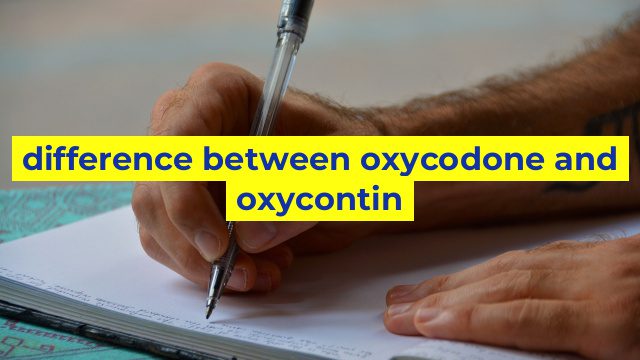The Difference Between Oxycodone and Oxycontin
Oxycodone and Oxycontin are two commonly used prescription drugs that are often used to treat moderate to severe pain. While they share some similarities, there are some significant differences between the two drugs that are important to understand.
What Is Oxycodone?
Oxycodone is a narcotic pain medication that is often prescribed for the treatment of pain that is severe enough to require around-the-clock treatment. This medication is derived from the same opiate family as morphine and heroin, and it works by binding to certain receptors in the brain and spinal cord to block pain messages from being sent to the brain.
Oxycodone is available in several different forms, including immediate-release and extended-release capsules, tablets, and oral solutions. This medication is approved by the FDA and is available by prescription only.
What Is Oxycontin?
Oxycontin is a brand name for a specific type of oxycodone extended-release tablet. This medication is designed to provide long-lasting pain relief for up to 12 hours, making it an excellent option for patients who require around-the-clock pain management.
Oxycontin works in much the same way as oxycodone, binding to opioid receptors in the brain and spinal cord to block pain messages. However, the extended-release formula of Oxycontin allows for a more even and sustained release of the medication over time, providing long-lasting relief.
Key Differences Between Oxycodone and Oxycontin
One of the most significant differences between oxycodone and Oxycontin is the duration of their effects. Oxycodone typically provides pain relief for up to six hours, while Oxycontin can last for up to 12 hours.
Another key difference between the two medications is their dosing. Oxycodone is available in several different strengths, including 5mg, 10mg, and 30mg immediate-release tablets, while Oxycontin is only available in extended-release tablets in strengths ranging from 10mg to 80mg.
Lastly, Oxycontin contains higher levels of oxycodone than regular oxycodone tablets, which makes it significantly more potent. This increased potency can make Oxycontin more effective at treating severe pain, but it also increases the risk of abuse and addiction.
Conclusion
In summary, while both oxycodone and Oxycontin are effective pain medications, there are some significant differences between the two that patients and healthcare providers should be aware of. Oxycodone provides six hours of pain relief while Oxycontin offers up to12 hours. Oxycontin also contains higher levels of oxycodone, making it more potent and effective, but also increasing the risk of abuse and addiction. Always talk to your healthcare provider about which medication is the best option for your specific needs.
Table difference between oxycodone and oxycontin
| Attribute | Oxycodone | Oxycontin |
|---|---|---|
| Generic name | Oxycodone | Oxycodone hydrochloride |
| Brand names | Roxicodone, OxyIR, Oxaydo | Oxycontin |
| Formulation | Immediate-release | Extended-release |
| Indication | Treatment of moderate to severe pain | Treatment of severe pain that requires around-the-clock treatment and cannot be managed by other medications |
| Dosing frequency | Every 4 to 6 hours | Every 12 hours |
| Strengths available | 2.5mg, 5mg, 10mg, 15mg, 20mg, 30mg, 40mg | 10mg, 15mg, 20mg, 30mg, 40mg, 60mg, 80mg, 120mg |
| Misuse potential | Can be misused or abused | Considered high risk for abuse and addiction due to its extended-release formulation and high potency |
| Administration | Oral tablet or capsule | Oral tablet (crush-resistant formulation) |
